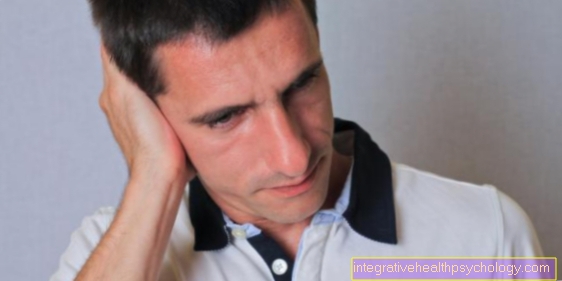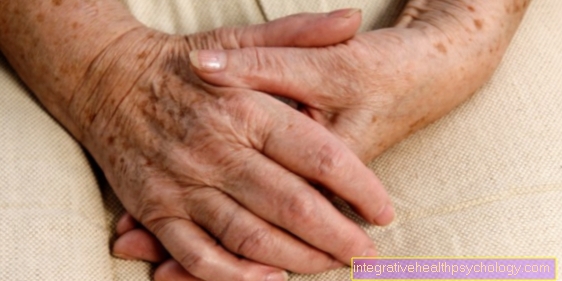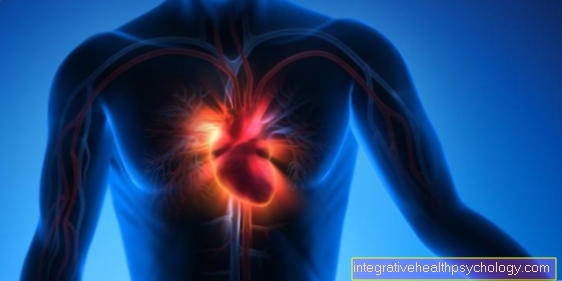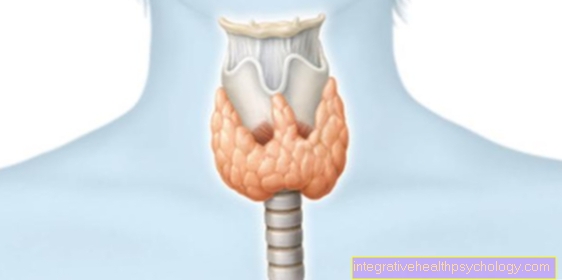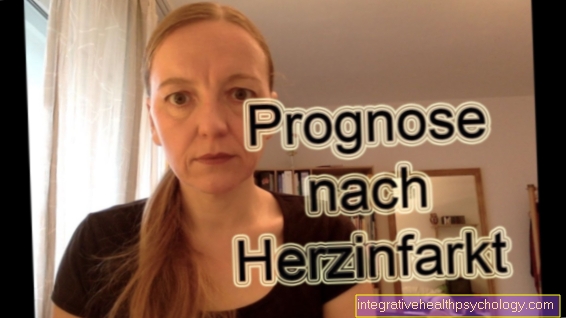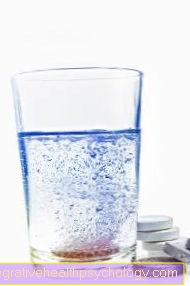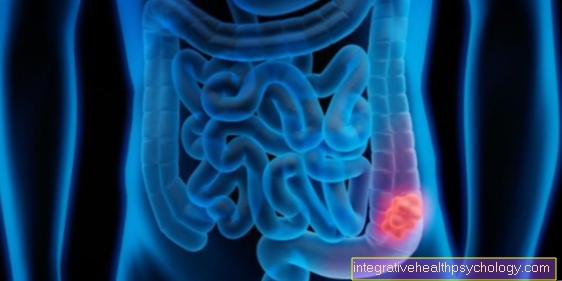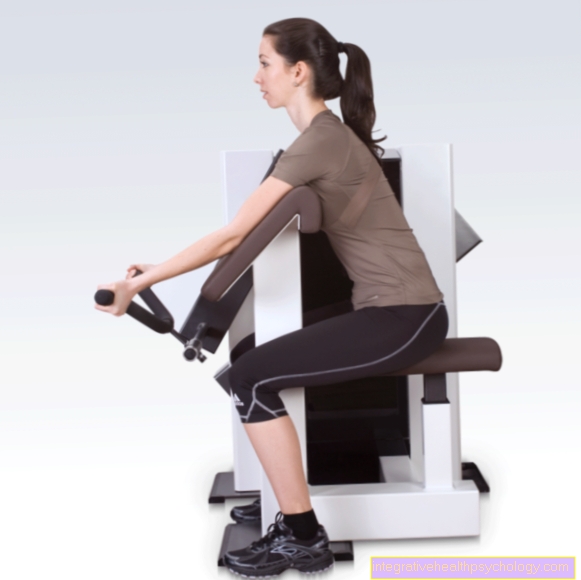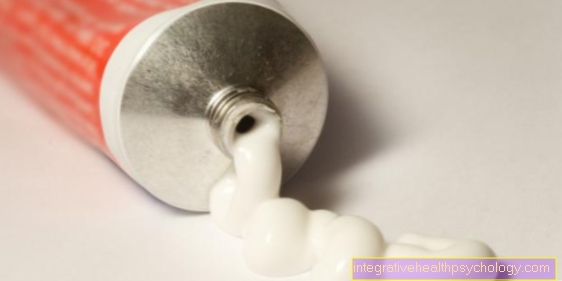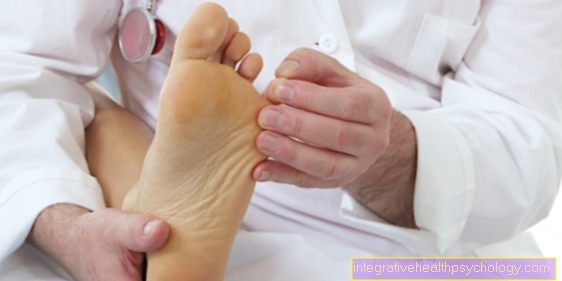Therapy for COPD
Therapy options
The therapy of COPD consists of the following measures and must be individually adapted.
- Avoid triggering noxae
- Medication
- Oxygen therapy and breathing apparatus
- night breathing apparatus
- Breathing exercises
- Infection prophylaxis

Avoid noxious substances
In therapy, it is very important to find the triggering factors for COPD and, if possible, to eliminate them. Usually this means that people should stop smoking to slow the progression of COPD. This presupposes an active willingness to cooperate (compliance) with the person concerned.
Read more about this under How to quit smoking
Medical therapy
Since the diameter of the bronchi is narrowed in COPD (chronic obstructive pulmonary disease), breathing is also more difficult because the resistance in the airways is increased. In order to reduce this resistance, one tries to widen the bronchi with medication.
On the one hand, this happens through quick and short-acting, inhalable drugs, which bind to very specific receptors of the vegetative nervous system (ß2 receptors of the sympathetic nervous system) and thus expand the bronchi. These drugs include substances like salbutamol or fenoterol (ß2 sympathomimetics) and serve to suppress acute shortness of breath.
Since the vegetative nervous system consists of two parts (sympathetic and parasympathetic) and plays a major role in breathing, a substance can also be administered that attacks the second component of the vegetative nervous system, the parasympathetic. Ipratropium belongs to this class of substances (Parasympatholytic agent), which is also inhaled and has a brief effect. To achieve a longer effect, substances such as tiotropium (belongs to the parasympatholytics) and salmeterol or formoterol (belong to the ß2-sympathomimetics) and usually inhaled twice a day.
Read more on the subject: Drugs for COPD
What does cortisone do?
Cortisone is a large group of anti-inflammatory drugs. They inhibit chronic inflammation within the airways and thus prevent acute flare-ups (Exacerbations) in front.
The cortisones used in COPD therapy are called Budenoside, Beclometasone and Fluticasone designated. They do not differ in their effect from cortisone, but have the advantage that their side effect profile is significantly lower, as they almost exclusively work in the airways. They are mainly used in advanced COPD (GOLD stage C / D) as well as in acute worsening (Exacerbation) used.
The above preparations are taken with the help of sprays. By inhaling the sprays deeply, the active ingredient gets directly into the airways.
Cortisone often shows only limited effectiveness in COPD (in contrast to bronchial asthma). Discontinuation of the preparation if there is no response or no improvement in symptoms is therefore recommended. Long-term use of cortisone in the airways significantly increases the risk of pneumonia.
Read more about this under
- Cortisone spray
- Effects of cortisone
- Side effects of cortisone
Bronchodilators
The airways (windpipe, bronchi) are surrounded by smooth muscles. These muscles are innervated by the autonomic nervous system (sympathetic, parasympathetic). While the sympathetic nervous system expands the airways by relaxing the smooth muscles, the sympathetic nervous system constricts the airways by contracting the muscles.
This mode of action is used in drug therapy for COPD. It comes from activation of the sympathetic nervous system (beta-2 sympathomimetics) as well as by inhibiting the parasympathetic nervous system (Anticholinergics or parasympatholytics) to an enlargement of the airways (Bronchodilation). For this reason, these groups of drugs are also known as bronchodilators.
Beta-2 sympathomimetics
Beta-2 sympathomimetics lead to an expansion of the airways by binding to beta-2 receptors of the sympathetic nervous system. A distinction is made between short-acting and long-acting preparations.
To the short-acting (SA = short acting) Drugs include salbutamol and fenoterol, while salmeterol, formoterol, and indaceterol the long-acting (LA = long acting) can be attributed.
The short-acting beta-2 sympathomimetics are used as reliever medication in the event of an acute worsening of COPD (Exacerbation). The long-acting beta-2 sympathomimetics, on the other hand, are used for long-term therapy of COPD. Depending on the GOLD stage, the therapy consists of one or a combination of several preparations.
Anticholinergics
Anticholinergics inhibit the parasympathetic receptors and cause the airways to widen.A distinction is also made here between short-acting and long-acting preparations.
The most commonly prescribed short-acting (SA) preparation is ipratropium bromide. This is used as reliever medication in the case of acute worsening of COPD (Exacerbation) used.
A long-acting (LA) anticholinergic is tiotropium bromide. This is used for long-term COPD therapy. Depending on the GOLD stage, the therapy consists of one or a combination of several preparations.
Read more about this under
- Anticholinergics
- Berodual®
Theophylline
Theophylline is a frequently used alternative to bronchodilators and cortisone. This is mainly used when symptoms fail to improve or when COPD is very advanced. In addition, it can be used in the most severe respiratory distress as part of an exacerbated COPD.
Theophylline inhibits inflammation within the airways as well as widening the airways by relaxing the smooth muscles.
In addition, theophylline also shows numerous side effects due to its unspecific inhibition of various enzymes and receptors. In addition to internal restlessness with insomnia and seizures, cardiac rhythm disorders and complaints in the gastrointestinal tract are also described. Theophylline should therefore under no circumstances be used in acute heart diseases (e.g. recent heart attack, cardiac rhythm disorders).
Read more about this under Theophylline
Phosphodiesterase-4 (PDE-4) inhibitor
Another alternative to the bronchodilators and cortisone described above is the active ingredient roflumilast. In contrast to theophylline, roflumilast specifically inhibits only one enzyme in the body (phosphodiesterase-4). As a result, there is less release of inflammatory messenger substances within the respiratory tract, which inhibits the immigration of further inflammatory cells.
Roflumilast is especially useful in the case of recurrent flare-ups (Exacerbations) indexed. It is often combined with long-acting beta-2 sympathomimetics. Since the enzyme (phosphodiesterase-4) is not only found in the respiratory tract, it can lead to very serious side effects (nausea, diarrhea, abdominal pain).
Oxygen and breathing apparatus
In some cases, oxygen therapy may be indicated. Those affected receive oxygen via a nasogastric tube, which can also be done at home.
Breathing masks worn at night are supposed to promote rest during sleep. A device ensures regular, sufficient breathing with sufficient oxygen supply.
When do you need oxygen?
The administration of oxygen is not based on the staging of COPD (GOLD stages). Instead, it depends on the oxygen saturation (sO2 value) in the blood. This indicates what percentage of the blood is saturated with oxygen - that is, how much oxygen is distributed through the blood in the human body. Usually this value is more than 95%.
With very severe COPD, the mucus in the airways can lead to lower oxygen saturation in the blood. The drugs administered as part of COPD therapy cannot widen the airways sufficiently to ensure adequate oxygen supply. The patient can only take in sufficient oxygen by breathing deeply in and out. With exertion, there is increasing difficulty in breathing. For these reasons, the administration of oxygen subsequently becomes necessary. This can relieve the respiratory muscles at the same time.
With the help of oxygen, the patient's mobility and quality of life can often be improved again. This enables extensive, independent care as well as long distances to be covered.
What is the point of physiotherapy?
In addition to drug therapy, physiotherapy is recommended for COPD. This depends on the individual severity and the symptoms of COPD. It strengthens the respiratory muscles, mobilizes the mucus in the lungs, alleviates coughing attacks and optimizes the effectiveness of COPD medication.
A frequent component of physiotherapy is respiratory training or respiratory physiotherapy. So-called PEP systems (positive expiratory pressure) generate excess pressure in the lungs, which can loosen the stuck mucus in the airways. Breathing training with the help of these PEP systems can also be carried out from home.
What does lung sport bring?
Lung sports include all breathing training to improve mobility and quality of life in COPD. Regular exercise strengthens the respiratory muscles, which means that you can breathe in and out more deeply and provide the body with more oxygen. In addition, by learning special breathing techniques (e.g. lip brake), lung collapse during exhalation can be prevented and breathing can be made possible without shortness of breath. Finally, learning how to cough up the mucus effectively and gently can also clear the airways.
Breathing exercises
Breathing exercises should be carried out to strengthen the muscles.
This includes exercises like the dosed lip brake. After inhaling, you exhale again against a resistance that is created by almost closed lips. The pressure in the airways is increased and thus counteracts a narrowing and collapse of the airways. It serves to strengthen the respiratory muscles, ventilate all lung areas and mobilize mucus.
More on this: Breathing exercises for COPD
Infection prophylaxis
Since COPD patients are prone to infections, especially of the respiratory tract, can be used as prophylaxis Vaccinations e.g. against the flu (Influenza) or against bacteria (e.g. Pneumococci) must be displayed.
What should be vaccinated against?
Due to the chronic inflammation in the respiratory tract, COPD patients have an increased risk of infections in the lungs. One of the reasons for this is that the chronic inflammation destroys the cilia within the respiratory tract, which, as part of the immune system, are supposed to ward off and remove germs.
For this reason, regular vaccinations are recommended by the Standing Vaccination Commission (STIKO). In addition to the annual flu vaccination (against influenza viruses), the patient should also be vaccinated once against pneumococci (pathogens that cause pneumonia). Depending on the severity of the COPD, additional vaccinations may be required.
Read more about this under
- The flu vaccination
- Vaccination against pneumonia
What does a cure do for me?
As part of a cure, both outpatient and inpatient rehabilitation measures can be carried out to alleviate COPD symptoms. The quality of life and mobility of a patient can be improved. In addition to regular physiotherapy (physical activity, respiratory physiotherapy), targeted breathing training as well as regular brine inhalations (saline solutions) and drainage storage can also take place. All in all, the patient's resilience can be increased again and the restrictions in daily life caused by COPD can be minimized.
Complications
COPD continues to advance. This progression depends very much on the cooperation of the person concerned. In the course of this, pulmonary emphysema, or overinflation of the lungs, so to speak, can develop. The heart is also exposed to increased stress. The result is increased blood pressure (high blood pressure) in the blood vessels that supply the lungs (pulmonary hypertension) and ultimately right heart failure (right heart failure).
The right heart failure leads in the further course to an increased left heart strain and in the end to a global weakness of the heart (global heart failure).
The complications also include those of smoking. Smoking poses an increased risk of a malignant tumor. Furthermore, smoking damages the blood vessels. Stroke, heart attack, or kidney failure (Renal failure) are just some of the consequences.
Read more on the topic: Superinfection
forecast
If the value of the one-second capacity is only 25% (i.e. if only a quarter of the volume can be exhaled within one second, which a healthy person exhales), the prognosis is unfavorable because there is usually cardiac insufficiency (Right heart failure). Of those affected, only 35% are still alive after 5 years.
Read more on the subject at: Life expectancy in COPD





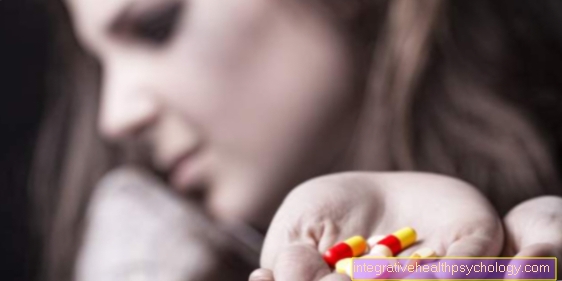
.jpg)
